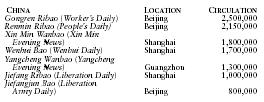China - Media
Postal service and telecommunications facilities fall under the authority of the Ministry of Posts and Telecommunications. The posts are responsible for the sale and distribution of newspapers and magazines, an important function in a country that relies heavily on these media for mass communication. Mail is delivered twice a day seven days a week. There were 53,600 post offices in 1990. In 2000, there were an estimated 135 million mainline telephones in use. In 2001, an additional 65 million cellular phones were in use.
Radio, Television and Internet
Television broadcasting began in 1958, and color transmissions in 1973. As of 1998 China had 369 AM and 259 FM radio broadcasting stations. In 1997, China Central Television operated 209 government-owned television stations. There were also 31 provincial stations and almost 3,000 city stations. The most important station is Beijing's Central People's Broadcasting Station (CPBS); from there, programs are relayed by local stations. CPBS broadcasts daily on several channels using a variety of languages, including Mandarin (or standard Chinese), the Hokkien and Hakka dialects, Cantonese, Mongolian, Tibetan, Uygur, Kazakhi and Korean.
In 2000 there were 339 radios and 293 television sets for every 1,000 people. Many of the TV sets are installed in public meeting places and in government and economic enterprises, although increasingly a television set has become a much-prized private acquisition. Since large segments of the rural population are as yet without radios and television sets, the government operates a massive wired broadcast network linked to over 100 million loudspeakers.
Despite controls, a rapidly growing number of Chinese have access to satellite television and the Internet. The government regulates access of the Internet through the Ministry of Information Industry and the Ministries of Public and State Security. In 2000 there were three Internet service providers, which were serving 26.5 million subscribers in 2001.
The Press
The press is closely controlled by the government, the CCP, or the various political and mass organizations associated with the CCP. Minority newspapers are published in Mongolian, Uygur, Tibetan, Korean, and other languages. The main news agencies are the official New China (Xinhua) News Agency; the China News Service, which supplies information to overseas Chinese newspapers and journals; and China Feature, which supplies articles to magazines and newspapers worldwide.
The Cultural Revolution caused substantial upheaval in the Chinese press establishment. Many publications closed down, and others underwent purges of editorial staffs. Publication of Hongqi ( Red Flag ), the most authoritative of the CCP publications, resumed in 1968.
The major newspapers, with their locations and circulations in 2002, are:

| C HINA | L OCATION | C IRCULATION |
| Gongren Ribao ( Worker's Daily ) | Beijing | 2,500,000 |
| Renmin Ribao (People's Daily) | Beijing | 2,150,000 |
| Xin Min Wanbao ( Xin Min Evening News ) | Shanghai | 1,800,000 |
| Wenhui Bao ( Wenhui Daily ) | Shanghai | 1,700,000 |
| Yangcheng Wanbao ( Yangcheng Evening News ) | Guangzhou | 1,300,000 |
| Jiefang Ribao ( Liberation Daily ) | Shanghai | 1,000,000 |
| Jiefangjun Bao ( Liberation Army Daily ) | Beijing | 800,000 |
Jiefangjun Bao , the army news, played a leading role in the Cultural Revolution. China's first English-language newspaper, the China Daily, founded in 1981, is published in Beijing and had a circulation of 150,000 in 1999. The most authoritative publication for foreigners is the multilingual weekly Beijing Review, which distributed in China and abroad, with a 1995 circulation of more than 100,000.
In 2002, Hong Kong had over 75 daily newspapers in circulation, some of which are English-language papers from other countries, such as the Toronto Star, the Boston Globe , and The Australian. Major Hong Kong dailies and there 2002 circulation are:

| H ONG K ONG | C IRCULATION |
| Tin Tin Yat Pao | 199,260 |
| Sing Tao Wan Pao | 125,000 |
| Wah Ku Yat Po | 125,000 |
| Ching Pao | 120,000 |
| Hong Kong Commercial Daily | 110,000 |
| South China Morning Post | 104,000 |
| Hong Kong Daily News | 101,815 |
The largest daily newspaper in Macau is Ou Mun Iat Pou ( Macau Daily News , 2002 circulation 100,000).
Though China's constitution states that freedom of speech and of the press are fundamental rights, in practice the Communist Party and the government control all print and electronic media, which are compelled to propagate the current ideological line. All media are under explicit, public orders to guide public opinion as directed by the authorities.
Comment about this article, ask questions, or add new information about this topic: